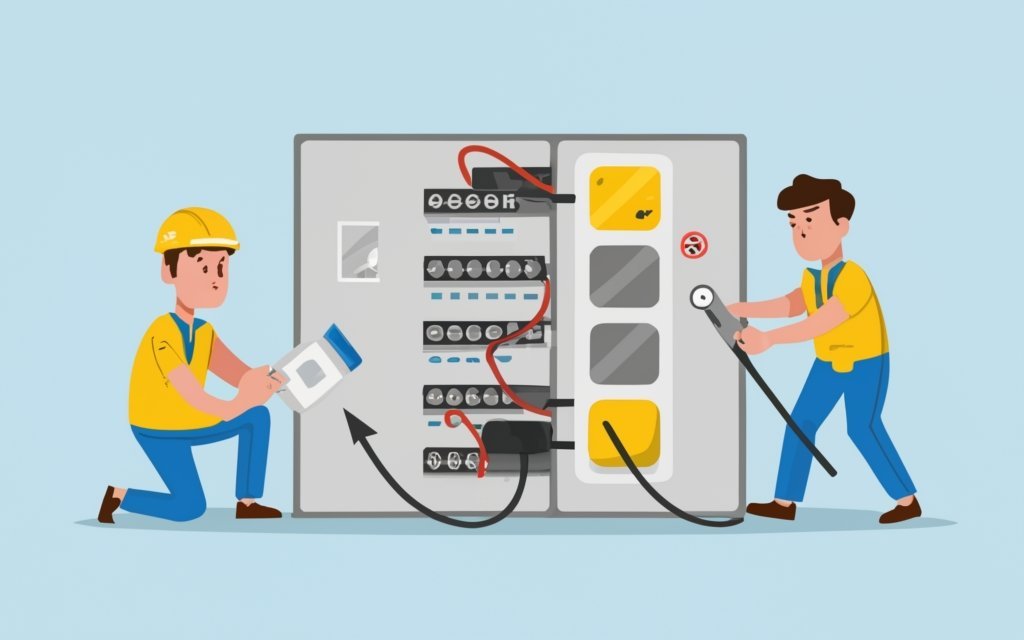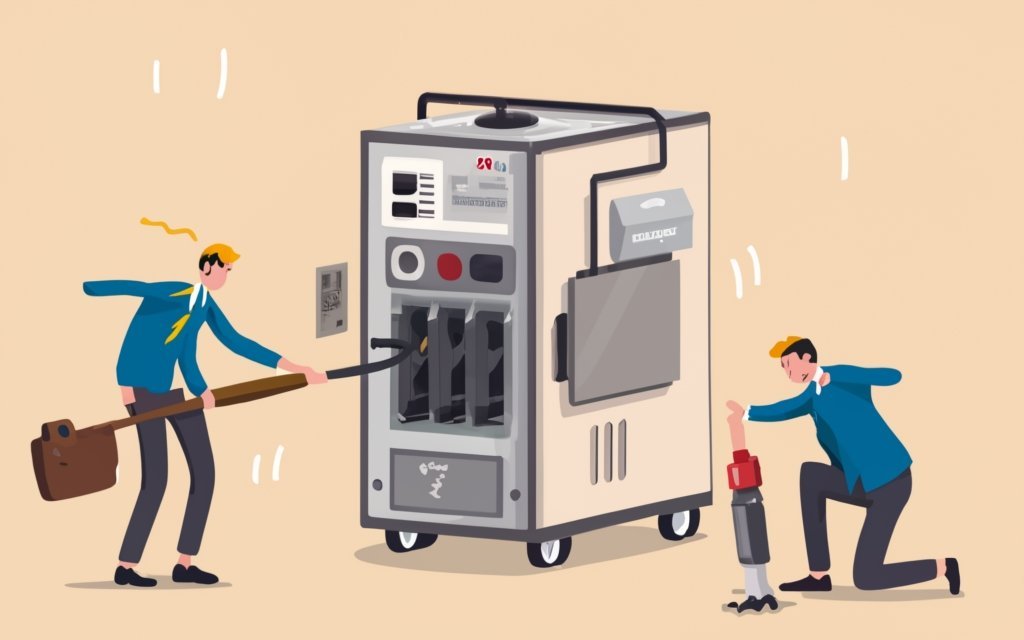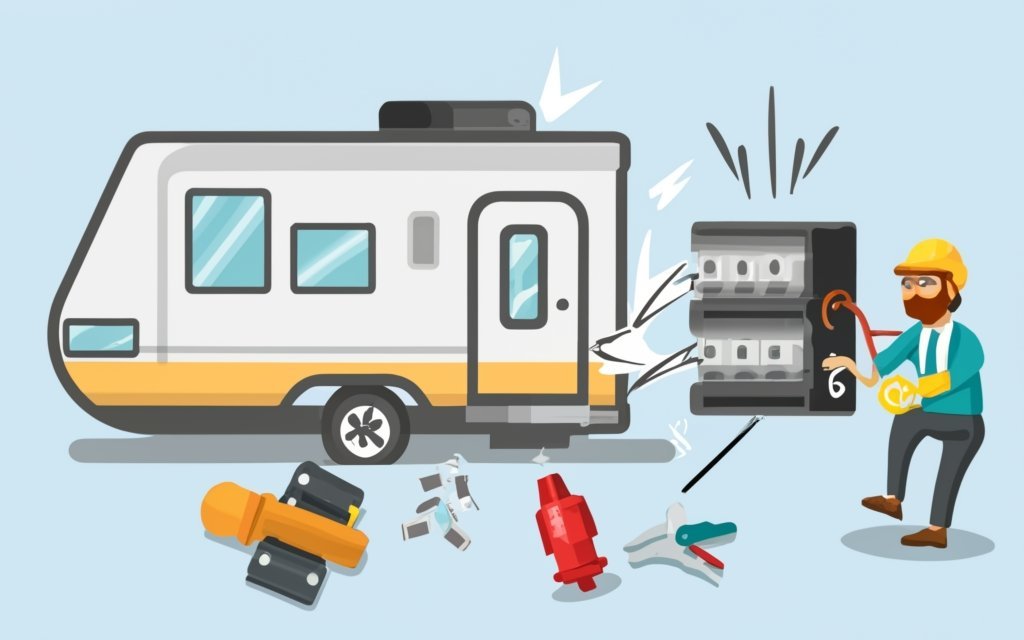A frustrating experience indeed! There are several reasons why your RV might be tripping the breaker, ranging from simple overloads to more complex electrical issues. Here are some potential culprits:
Overloading:
- Exceeding amp limit: Check your RV’s amp rating (usually 30 or 50) and compare it to the amp rating of the outlet you’re plugged into. Ensure you’re not drawing more power than the circuit can handle, especially when running high-consumption appliances like AC or water heaters.
- Multiple appliances: Turn off all unnecessary appliances before turning on high-demand ones. Consider staggering usage to avoid exceeding the amp limit.
Electrical issues:
- Faulty wiring: Damaged or loose wiring in your RV can cause shorts and trip the breaker. Look for signs of overheating, burning, or discoloration.
- Appliance malfunction: A faulty appliance can draw excessive power or leak current, tripping the breaker. Try isolating the culprit by turning on appliances one by one and monitoring the breaker.
- GFCI outlet issues: If you’re plugged into a GFCI outlet, a slight ground fault in your RV’s electrical system can trigger the outlet’s safety mechanism.
Other factors:
- Low voltage: Check the voltage coming from the power source. Low voltage can cause some appliances to draw more power, potentially tripping the breaker.
- Weather conditions: Hot weather can increase the demand on your electrical system, making it more prone to tripping. Consider reducing appliance usage during high temperatures.
Troubleshooting tips:
- Identify the breaker tripping: Note which breaker in your RV or campground panel trips to narrow down the potential source.
- Turn off all appliances: Start with all appliances off and turn them on one by one to identify the culprit.
- Check for GFCI faults: Press the reset button on any GFCI outlets connected to your RV.
- Visual inspection: Look for signs of damage in your RV’s wiring or appliances.
- Professional help: If you’re unsure about the cause or uncomfortable troubleshooting yourself, seek help from a qualified RV electrician. There is another article I wrote about >>>>> Why Does My RV Air Conditioner Smell Musty? to learn more about different parts of RVs.
Remember, safety is paramount. If you suspect a serious electrical issue, don’t hesitate to call a professional.
1: Amped Up Adventures: Demystifying Tripped Breakers in Your RV.
Ah, the open road, the wind whipping through your hair, the freedom of the boundless horizon…until BAM! Your RV’s lights flicker, appliances sputter and the dreaded click plunges you into electrical darkness. Yep, you’ve just crossed paths with the infamous tripped breaker, the bane of every RVer’s existence. But before you throw in the towel (or worse, start rewiring with duct tape), let’s untangle this amp-tastic mystery.
Understanding the Jargon:
First things first, let’s ditch the electrician lingo and break it down:
- Amps: Think of amps as water flowing through electrical wires. The higher the amp rating, the wider the pipe, and the more power it can handle. Your RV usually has a 30A or 50A rating, like the size of your garden hose.
- Volts: Imagine voltage as the water pressure pushing that flow. Higher voltage means a stronger push, but too much can burst the pipe (think fried circuits!). Standard shore power is 120V, like city water pressure.
- Watts: Watts are like the work your appliances do with that water/electricity mix. A high-powered AC unit is like a thirsty lawn sprinkler, guzzling more watts than a simple reading lamp.
The Amp vs. Appliance Tango:
Now, imagine your RV’s electrical panel as a bustling city center, with each appliance a demanding resident. Every time you switch on that AC or microwave, they tap into the main power line, drawing their required “amp-bucks” to function. But there’s only so much to go around! So, if everyone tries to withdraw at the same time (think rush hour!), the system overloads, and the breaker (our trusty traffic cop) throws the switch, cutting off the power to prevent a meltdown.
Table 1: Common Amp Hogs in Your RV:
| Appliance | Approximate Amp Draw |
|---|---|
| Air Conditioner | 13-15 A |
| Microwave | 7-11 A |
| Water Heater (Electric) | 10-12 A |
| Hairdryer | 8-14 A |
| Coffee Maker | 8-12 A |
Pro Tip: Keep track of your amp usage! Many RV panels have meters, or you can invest in a handy portable amp meter. Seeing those numbers climb can be a real-time power play, helping you prioritize appliances and avoid the dreaded trip.
Part 2: When Amps Go Rogue: Diagnosing the Tripped Breaker:
So, your breaker’s thrown a tantrum. Now what? Don’t panic! Grab your detective hat and let’s crack this case:
The Usual Suspects:
- Overload: Did you accidentally turn on the hair dryer while the AC was blasting? That’s a recipe for overload! Check which appliances were running when the breaker tripped and try a staggered approach to avoid exceeding your RV’s amp limit.
- Faulty Wiring: Sometimes, wires get loose, worn, or even damaged, like a kinked garden hose. This can disrupt the flow and even cause sparks, so keep an eye out for any suspicious burns or discoloration around your RV’s electrical system.
- Appliance Malfunction: Maybe your trusty AC unit has developed a power-guzzling gremlin. Try isolating the culprit by turning on appliances one by one and monitoring the breaker. A faulty appliance might need repair or replacement.

Beyond the Basics:
- Low Voltage: Sometimes, the problem isn’t your RV, but the source itself. A weak campground outlet or a long extension cord can cause the voltage to drop, making appliances work harder and drawing more amps. Check the voltage at the source and consider alternative power options if needed.
- GFCI Gremlins: These special outlets have a built-in safety switch that trips if it detects even the tiniest electrical leak. While annoying, it’s a good thing! Try resetting the GFCI and identifying the source of the leak, which could be a faulty appliance or even moisture in the outlet itself.
Remember: When in doubt, don’t hesitate to call a qualified RV electrician. They’re the electrical superheroes who can diagnose and fix even the trickiest amp-tastic troubles.
Stay tuned for Part 2, where we’ll dive deeper into advanced troubleshooting tips and pro advice to keep your RV’s electrical system purring like a well-oiled engine!
This is just the beginning of your comprehensive guide to conquering tripped breakers and amplifying your RV adventures. Stay tuned for the next section, where we’ll take things up a notch with even more expert insights.
Part 3: Taming the Tripped Breaker: Advanced Troubleshooting and Pro Tips.
Alright, adventurers, we’ve identified the usual suspects behind those pesky tripped breakers. Now, let’s take your electrical expertise to the next level with some advanced troubleshooting strategies and pro tips:
III. Amp Detective: Tools of the Trade:
- Voltage Meter: Your trusty pocket Sherlock. This nifty gadget measures voltage at the source and within your RV, helping you pinpoint low-voltage gremlins.
- Electrical Panel Decoder: No hieroglyphics here! Understand your RV’s electrical panel layout. Identify breakers for specific circuits and learn to interpret those cryptic labels. Knowledge is power (literally)!
- RV Maintenance Manual: Your RV’s personal bible. Refer to it regularly for specific electrical specifications, maintenance tips, and troubleshooting guidance.
IV. Proactive Power Play: Staying Ahead of the Curve:
- Regular Inspections: Don’t wait for the lights to dim! Regularly check your RV’s electrical system for loose connections, damaged wires, or potential hazards. Early detection prevents major meltdowns.
- Surge Protector Savior: Shield your RV from unexpected voltage spikes (think summer storms!) with a quality surge protector. It’s like an electrical bodyguard, taking the hit so your gadgets stay safe.
- Power Planning Mastermind: Think ahead! When boondocking or using generators, calculate your total amp draw before plugging in appliances. Use extension cords wisely and avoid overloading circuits. Remember, amps add up faster than campfire stories!

Bonus Tip: Consider upgrading your RV’s batteries with deep-cycle batteries designed for sustained power output. This can be a game-changer for off-grid adventures, allowing you to run essential appliances without tripping the breaker.
V. When All Else Fails: Calling in the Cavalry:
Remember, your safety is paramount. If troubleshooting leaves you stumped or you suspect a major electrical issue, don’t hesitate to call a qualified RV electrician. They have the expertise and tools to diagnose and fix complex problems, ensuring your adventure rolls on smoothly.
Beyond the Breakers:
This guide has been your compass through the amp-tastic world of RV electrical systems. But the journey doesn’t end here! Explore these additional resources to deepen your knowledge and become a true master of electrical adventures:
- RV Forums and Communities: Connect with fellow RV enthusiasts, share experiences, and learn troubleshooting tips from the community.
- Online RV Maintenance Guides: Find detailed resources and tutorials on RV electrical systems, maintenance, and repair.
- Professional RV Electrician Network: Locate a qualified RV electrician near you for expert advice and assistance.
With a little knowledge, proactive maintenance, and the right tools in your arsenal, you can conquer tripped breakers and keep your RV adventures humming on all cylinders. Remember, power lies in understanding, so keep exploring, keep learning, and keep on adventuring!
Part 4: Power Up Your RV Know-How: Additional Tips and Insights
V. Beyond the Basics: Deeper Dive into RV Electrical Systems.
Ready to take your electrical expertise to the next level? Let’s explore some more advanced concepts and considerations:
1. Understanding AC vs. DC Power:
- AC (Alternating Current): The standard power source in most homes and campgrounds, it’s like a continuous wave of electricity, changing direction 60 times per second.
- DC (Direct Current): The power stored in your RV’s batteries, it flows in a single direction, like a steady stream.
- Converters and Inverters: These devices bridge the AC/DC divide, allowing you to use AC appliances when running on battery power or DC appliances when plugged into shore power.
2. Shore Power vs. Generators vs. Batteries:
- Shore Power: The most common external power source, typically 120V AC, is provided at campgrounds and RV parks.
- Generators: Portable power plants that create AC power, often used for boondocking or when shore power isn’t available.
- Batteries: Store DC power for off-grid use, charged by solar panels, generators, or shore power.
3. Electrical Safety:
- Ground Fault Circuit Interrupters (GFCIs): Protect against electrical shock by monitoring for ground faults and tripping instantly if detected.
- Proper Wire Sizing: Ensure wires are rated for the correct amperage to prevent overheating and fires.
- Regular Maintenance: Inspect electrical components for wear and tear, and make repairs promptly.
VI. Conquering Common RV Electrical Challenges:
1. Dealing with Low Voltage:
- Check the power source: Ensure the campground outlet or generator is providing adequate voltage.
- Upgrade extension cords: Use heavy-duty cords with the correct gauge for longer runs.
- Install a voltage booster: Consider a device that can increase the voltage of your RV’s electrical system.
2. Managing Battery Power:
- Monitor battery levels: Use a battery monitor to track usage and prevent over-discharge.
- Optimize charging: Use solar panels, generators, or shore power to fully recharge batteries.
- Upgrade batteries: Consider deep-cycle batteries designed for sustained power output.
3. Maintaining Electrical Systems:
- Clean connections: Keep terminals and connectors free of corrosion, ensuring good contact.
- Inspect wiring: Look for signs of damage, loose connections, or wear and tear.
- Seek professional help: Consult a qualified RV electrician for regular maintenance or troubleshooting.
Remember, knowledge is power! By understanding the fundamentals of RV electrical systems, practicing proactive maintenance, and seeking professional help when needed, you can keep your RV’s electrical system running smoothly and safely, ensuring your adventures stay bright and powered up for the long haul.
Part 5: Embracing Innovation: The Future of RV Electrical Systems.
VII. Green Thumbs and Watts: Sustainable RV Power Options.
As we strive for a greener future, so too does the world of RVing. Embrace the exciting developments in sustainable power options and make your adventures eco-friendly:
- Solar Power: Harness the sun’s energy! Install solar panels on your RV roof or portable units to generate clean, free electricity from the sun.
- Lithium-ion Batteries: The eco-conscious upgrade! These batteries offer longer life, faster charging, and lighter weight compared to traditional batteries, minimizing environmental impact.
- Fuel-Efficient Technologies: Look for RVs featuring advanced generators or hybrid systems that burn fuel more efficiently, reducing emissions and increasing your mileage.

VIII. Staying Connected: The Rise of RV Connectivity and Smart Systems.
The future of RVing is all about staying connected and in control. Explore the latest advances in technology that elevate your RV experience:
- Remote Monitoring and Control: Manage your RV’s electrical systems from your phone! Adjust temperatures, monitor battery levels, and even control appliances remotely for ultimate convenience.
- IoT Integration: Connect your RV appliances and features to the Internet of Things (IoT) for automated and personalized experiences. Imagine climate control adjusting automatically based on your preferences!
- Smart Safety Features: Enhance your RV’s safety with smart sensors and alerts. Monitor gas levels, carbon monoxide leaks, and potential electrical hazards for peace of mind on the road.
By embracing these evolving technologies, you can enjoy a more sustainable, connected, and comfortable RV experience, paving the way for a thrilling future of adventure travel.
Remember: As technology continues to evolve, staying informed about the latest advancements in RV electrical systems is crucial. Join online communities, attend workshops, and consult with knowledgeable experts to keep your RV’s power game constantly upgraded.
With this comprehensive guide, you’re now equipped with the knowledge and expertise to conquer tripped breakers, optimize your RV’s electrical system, and embrace the exciting future of sustainable and smart power on the road. So, hit the gas (or turn on the solar panels!), crank up the tunes, and let your next adventure be powered by your newfound electrical mastery!
Bonus Tip: Consider investing in an RV maintenance logbook to track electrical system checks, repairs, and upgrades. This can be a valuable asset for ensuring your RV’s electrical health and preventing future headaches.
I hope this concludes your guide with a satisfying touch of the future, encouraging readers to embrace innovation and enjoy the ever-evolving world of RV electrical systems. Safe travels and happy adventures!

Welcome to the enchanting world of Genah Reney, the esteemed Author-in-Residence at BAF TOURS International. Genah is not only a master storyteller but also a guiding force in weaving narratives that elevate the travel experience. Her literary prowess mirrors the essence of BAF TOURS, creating a seamless blend of captivating stories and the allure of global exploration.






